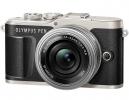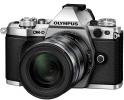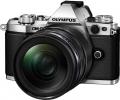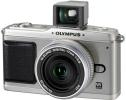Reviews related to : Olympus
Every new Pen camera from Olympus is a pleasure to review. For such a small overall unit to give brilliant quality images and video without you having to be a semi-professional user is great. This latest offering camera only was sent with the new 14-42mm lens so I could review it.
The Olympus Pen E-PL10 measures 12.5x6x6cm and weights 471 grams. There is about 3cm of extension with the lens. Let’s start with the top of the camera, pop up flash, flash shoe, nine position wheel, and finally on/off button. On either side of the top are neck strap anchor points. The left side is clear, while the right side has a door covering HDMI and USB sockets. The base has tripod screw and the solid battery bay as well as SD slot. The face has the motorised lens.
This offering was sent to me body only but with a 12-40 lens for my testing. I was surprised first by the way it arrived in a brown box with each part bubble wrapped and second when I mentioned no manual to be told no printed manuals are supplied now with any of our cameras. Even for someone used to using an interchangeable lens unit surely no manual is not the way to go, however you can still download one in PDF from the website.
The Olympus OM-D E M5 III body measures 11.5x8x4.5cm without lens. With the supplied 12-40mm lens attached the last figure increases to between 12.5 and 15.5cm. The weight is 800 grams without neck strap which I assume is included although not sent to me. All the outputs are on the left side behind rubber bungs. The base has tripod screw and solid battery bay, the SD card slot is on the right behind a snap shut door.
It been a while since I have reviewed a camera that can fit in your pocket, of course most recent SmartPhones have better than average cameras but I do not know any that can shoot underwater as this latest offering from Olympus can.
While it was clearly marked sample and it was just the camera no leads and most importantly no manual, I was able to download the manual sometime later and this helped me to fill in some of the things that the camera is capable of that I was unable to figure out without it. I defy most to get anything like the best from this unit without a thorough read of the 168 pages of the manual.
This is an enthusiasts camera, quality in a small package, but still able to give excellent ‘auto’ images and if you know better then the various special scene and manual mode allow you to get that extra special image to say great.
The Olympus Olympus PEN E-PL9 measures 12x6.5x6cm when off the powered zoom can take the 14-42mm lens out to 9.5cm. It weighs 513grams with the supplied neck strap in situ. People who have fondled it say that’s heavy and my response is that is quality down to the dark blue leather that goes round the front and sides.
While a lot of better mobile phones has decent enough cameras I still get a buzz to test out a proper interchangeable lens camera from a good manufacturer. Here is such an item from Olympus now at M5 iteration II.
The The Olympus E M5 II is not a large unit but is powerful and the images its takes are superb. As always I start in Auto mode while I familiarize myself with everything it can do.
This is a small removable lens camera from Olympus that goes under the ‘Pen’ name that Olympus first created several years ago with a single offering that has now grown into a brand all of their own for small easy to use quality cameras.
The Olympus Pen E-PL8 measures 12x6.5x6cm and weighs only 528grams with neck strap and flash unit attached, the latter increases the last figure the height by 2cm. Going around the camera, the left side has only the neck strap anchor point; the right side has its pair as well as mini USB and HDMI sockets behind a flip door. The base has the solid battery behind a door that is also where you insert any SD Card you use, further along the base is a tripod anchor point.
This sadly is one of those occasions where the launch bears no resemblance to the availability of review samples, so while I was ready to go when the launch came my memory of exactly what the camera can do was somewhat dimmed by the time taken for one to arrive which means the time required to review is longer.
This is a camera that can work on land or under water, when used in the latter condition the ability to get a level shot may or may not be important but it does have both horizontal and vertical levels, it is of course fully waterproof and can withstand the odd drop as I remember from the presentation day. If can also function in extremes of temperature. The zoom is quite impressive and is of course periscopic to avoid any possible leak points with the normal lens expansion. The camera is 11.
This is a DSLR in a body so small that you assume it isn’t. It comes with a 14-42mm lens and is smaller than even some small digital cameras, it has a neck strap it has a viewfinder and it has a flash shoe in normal conditions you might never use any of them.
The Olympus OM-D measures 12.5x7x8cm and weights 534grams. The right side has a neck strap anchor and a hinged door behind which any SD Card you use lives. The left side has the other neck strap anchor and a rubber bung over the external connectors. The back has a 6x4.
This is a small video camera that is designed to be fitted to you rather than held by you, the main people to take advantage of this are those who take extreme sports to a new level and record their progress and then when they show their mum get told what an $%^&* they are.
The latest Olympus product allows you to record your audio memories.
Following the release of its LS Linear PCM audio recorders in 2014, Olympus has now developed its LS Pocket Series of Hi-res audio recorders. I have been trying out the pocket sixed LS-P1 unit which is the base model in the series. With dimensions of 108.9 x 39.1 x 14.1mm (H x W x D) and weighing 75g (including the battery) the LS-P1 is eminently portable whether carried in a pocket / bag or held in the hand for capturing sound bytes or whole audio performances when attending a concert.
Three years ago Olympus launched their LM-12 and LM-14 high quality voice and music recorders, the LM-14 was unique in having three microphones. Now they have launched the LS-P1 (4GB internal memory) and LS-P2 (8GB internal memory) the latter also has three microphones but is a lot smaller.
The Olympus LS-P2 audio recorder weighs only 75grams and is 11x4x1.5cm so will fit easily in the palm of your hand. Having used the LM-14 for a lot of music recording I know how helpful the ‘third microphone’ is for capturing base notes. So the LS-P2 with the third mic was the obvious choice for me. Going around the outside has a 3.5mm headphone/earbud socket and then an external microphone 3.5mm socket and if you are testing in a low light setting this could lead to problems.
I saw a pre-production model of this unit back in the summer. Now finally as winter grips us all the chance to review it arrives. For me a first, a removable lens camera marketed with the ability to take selfies high on its tick list.
It is 12.5x6.5x8.5cm and weights 453grams without neck strap or flash attached. The lens it came with is a 14-42mm and the action is very smooth. The left side has only the neck strap anchor point while the right side has the matching anchor point as well as a rubber bung behind which are mini HDMI and AV out sockets. The base has a tripod screw and a door behind which is the solid battery and any SD card you insert. The face has just the lens and the light sensor.
I normally think of Olympus as a manufacturer of removable lens cameras which normally makes then larger than pocket size. Here a unit that will easily fit in a pocket and also one that can survive the odd drop or immersion in water.
The Olympus Tough TG-850 measures 11x6x2.5cm and weights 216grams. Because it is waterproof the zoom is internal so the dimensions given are maximum. There is a printed ‘Basic Manual’ in 29 languages, the full manual together with software is on a supplied CD-ROM. Charging is by USB but lose the supplied lead as the end that fits in the camera is not standard. The face has the lens top right with the flash beside and slightly behind it 1.5cm away.
Olympus is a name big in cameras and voice recorders. So here a slight deviation of the latter into music recording and indeed the microphones needed to impart full range audio recording required for such a complex task.
I have used several audio recording devices and while the sound is normally recorded correctly the main problem is that the range is lost and this is mainly reproduced with treble heavy and bass light results. So any unit with a separate microphone to record bass is certainly worth a good test.
With its menu of cameras and recorders, a recent Olympus event introduced me to the companys range of hand-held audio recorders.
It has been several years since I last had the opportunity to check out an audio recorder from Olympus. That period of separation has been brought to a conclusion with the arrival of the company’s LS series of smart Linear PCM (Pulse Code Modulation) recorders. Unlike those earlier recorders, this device is aimed specifically at the musician but could also prove useful for other types of customer. The new range of Olympus LS Linear PCM recorders features three models.
Voice Recorders have been around for a long time, mainly as an office tool for the executive wanting to dictate notes or letters when away from the office. Of course many other devices such as MP3 players can do this now.
It is 9.5x3.7x1cm and weights 44grams when the single ‘AAA’ battery is inserted. I always try to use such devices without – initially – resorting to the manual. Here I was able to record and replay messages I left on the unit without any problem. Looking at the controls one thing seemed to be missing and that was an off switch, however I found after a period of inactivity it shut itself down. The face has a 2.
Not a writing instrument as you may think from the title, but a DSLR camera, this designed to look like an SLR of a long time ago. It takes brilliant images in daylight; alas I cannot tell you about night time shots as no flash was supplied.
The Olympus Pen E-P1 measures 12x7x11cm with the supplied 14-42mm lens fully extended. It weights 550grams including the supplied neck strap. It is supplied as standard without a flash, a hot-shoe socket is on the top and almost any flash can be fitted. A small rectangular module is mentioned but at the time of my review one was not available to be sent to me so all my tests were in daylight.
Although many users tend only to think of Olympus as a developer and manufacturer of traditional and digital cameras, the company also has a long established reputation for producing high quality digital voice recorders.
Recently the company expanded its range of voice recorders with three new models in its DS series. These models are the DS-30, DS-40 (the subject of this review) and the DS-50. Measuring 110 x 37.5 x 16mm and weighing 73g, the DS-40 is a handy size device in more ways than one. It will fit easily into a pocket or bag, without an unsightly bulge, when not in use.
Having recently looked at a DSLR from Olympus this is the other end of the scale however not only is it small and has a decent zoom but it is also close to waterproof.
The Olympus μ780 weights under a 150grams, will fit in the palm of an adults hand. It is 10x5.5x2.5cm and is made of aluminium. The right side has a dual slot for DC input and USB AV out. The left side is blank while the base has insertion point for the solid battery and the same cover covers for the optional XD card, the base also has screw fixing for a tripod.
Since I last looked at a voice recorder they have come a very long way, no tapes now they have built in memory and the sound quality is light years away from what it was.
There are in fact three different machines the DS-30, DS-40 and the top of the range DS50. They are different colours and the size of the built in memory varies. Whichever one you get they all record in WMA but to avoid death by initials I will just say you can pick recording rates from the worst LP 8kHz (8kbps) up to STXQ 44.1kHz (128kbps).


























